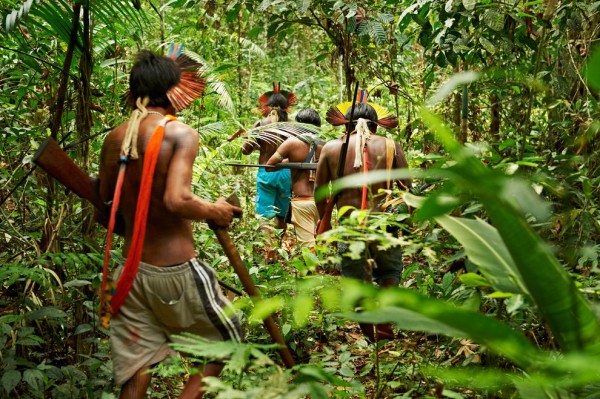Rain Forest Warriors: How Indigenous Tribes Protect the Amazon
With outside help, tribes like the Kayapo defend their land against ranchers, loggers, and miners.

Kayapo warriors move through the forest with shotguns and axes in search of fresh game.
The destruction of the Amazon in Brazil can be seen by satellite: Where logging roads have spread their tentacles and ranchers have expanded their grazing, all is brown.
Beginning in the early 1980s, these photos from space lost more and more green, so that by 2004 the destruction seemed unstoppable. Brazil’s deforestation rate had reached an alarming 27,000 square kilometers (nearly 17,000 square miles) per year.
But stop it did—not everywhere, but at the borders of what appears from space to be a green island the size of a small country. The brown spreads around this protected zone in the southern Xingu river basin of Brazil, but doesn’t penetrate.
These are the borders of the lands of indigenous tribes.
A Lesson for Environmentalists
The massive green island is comprised of ten legally ratified indigenous territories totaling 35 million acres (14 million hectares). The forest is home to roughly 7,000 Kayapo Indians and, to the south, another 5,500 Indians from 14 different groups.
(Read “Kayapo Courage” in National Geographic magazine.)
For those who want to protect the Amazon, there’s a lesson here. How do relatively few indigenous people manage to keep the chainsaws and bulldozers at bay over a vast area of pristine forest?
Legal protections are part of the answer: Threatened by ranchers, loggers, and gold miners on their borders, the Kayapo fought for and won official recognition of their lands in the 1980s and 1990s. (Their southern neighbors were already living in a smaller protected area, the Xingu Indigenous Park, established in the 1960s.)
But this region of the southeastern Amazon is like the Wild West, a territory lacking proper governance. Violent conflict over land, illegal logging and gold mining, fraudulent land deals, and other corruption are rampant. Laws are not protection enough.
Understanding the Enemy
Some native tribes have staged protests, pressured the government, and fought on the ground to secure their rights. Some have also formed alliances with environmental and indigenous-rights organizations, which have helped them to form their own nongovernmental organizations (NGOs), enabling them to enlist further outside backing.
One example: Overflights of Kayapo territory in recent years, funded by outside NGOs, spotted gold miners in a remote area. After government inaction, the outside partners equipped a Kayapo expedition with boats, motors, fuel, GPS, and radio.
In July, several dozen Kayapo warriors traveled more than 200 kilometers (124 miles) by boat and on foot to strike at the illegal mining camps. They destroyed the mining equipment and pressured the government to send helicopters to take the captured miners away.
NGOs have also supported initiatives to help the Kayapo become economically more self-sufficient. These include a program to harvest and sell hundreds of thousands of dollars’ worth of Brazil nuts, giving families needed income and reducing pressure to allow in loggers and miners in return for cash.
New Threats
The Amazon rain forest is the greatest expression of life on Earth. It is home to about a third of our planet’s terrestrial life forms, cycles about one-quarter of the Earth’s freshwater, and plays a key role in absorbing carbon and moderating climate.
The need to remain vigilant and engaged is constant. Destruction of rain forest continues, and the powerful agriculture, mining, and logging lobbies in Brazil are proposing amendments to the 1988 constitution that would, in effect, remove legal protections from indigenous lands.
More outside assistance and deeper alliances with the indigenous tribes of the Amazon are urgently needed.
Click on the links below to learn more about what you can do to help save Amazon rain forest and indigenous cultures.



Leave a reply